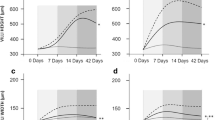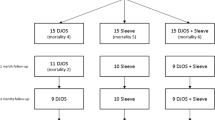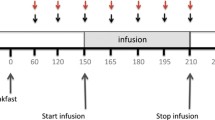Abstract
Postprandial augmentation of absorption of water and electrolytes is believed to occur in the jejunum. Neural mechanisms of control, however, have not been studied in the in situ jejunum or in the transplanted bowel. The aim of this study was to determine if postprandial augmentation of absorption occurs in the in situ jejunum and to evaluate neural mechanisms controlling postprandial jejunal absorption. Based on our previous work, we hypothesized that postprandial augmentation of absorption does not occur in the jejunum in situ and that extrinsic denervation of the jejunum is associated with decreased postprandial absorption. Absorption was studied in an 80 cm, in situ jejunal segment in six dogs by using an isosmolar electrolyte solution alone, or with 80 mmol/L glucose before and after jejunal transection to disrupt intrinsic neural continuity of the study segment with the remaining gut. Net absorptive fluxes of water and electrolytes were measured in the fasted state and after a 400-kcal meal. Another six dogs were studied 3 weeks after our validated model of extrinsic denervation of jejunoileum; identical fasting and postprandial absorptive states were evaluated. Postprandial augmentation of absorption of water and electrolytes did occur in the jejunum (P<0.03) both in the absence and in the presence of intraluminal glucose. After intrinsic neural transection or extrinsic denervation, no postprandial augmentation of absorption occurred, with or without glucose. Postprandial augmentation of absorption of water and electrolytes occurs in the in situ jejunum. Disrupting intrinsic neural continuity or extrinsic denervation (as after intestinal transplantation) abolishes postprandial augmentation.
Similar content being viewed by others
References
Nishida S, Levi D, Kato T, et al. Ninety-five cases of intestinal transplantation at the University of Miami. J GASTROINTEST SURG 2002;6:233–239.
Abu-Elmagd K, Reyes J, Bond G, et al. Clinical intestinal transplantation: A decade of experience at a single center. Ann Surg 2001;234:404–417.
Thompson JS, Rose SG, Spanta AD, Quigley EM. The longterm effect of jejunoileal autotransplantation on intestinal function. Surgery 1992;111:62–68.
Herkes SM, Smith CD, Sarr MG. Jejunal responses to absorptive and secretory stimuli in the neurally isolated jejunum in vivo. Surgery 1994;116:576–586.
Oishi AJ, Sarr MG. Intestinal transplantation: Effects on ileal enteric absorptive physiology. Surgery 1995;117:545–553.
Sarr MG, Kelly KA, Phillips SF. Canine jejunal absorption and transit during interdigestive and digestive motor states. Am J Physiol 1980;239:G167-G172.
Sarr MG, Kelly KA, Phillips SF. Feeding augments canine jejunal absorption via a hormonal mechanism. Dig Dis Sci 1981;26:961–965.
Bastidas JA, Orandle MS, Zinner MJ, Yeo CJ. Small-bowel origin of the signal for meal-induced jejunal absorption. Surgery 1992;108:376–383.
Libsch KD, Zarroug AE, Duininck TM, Ueno T, Duenes JA, Sarr MG. Extrinsic denervation alters postprandial absorption of glucose and glutamine in the ileum. Implications for small bowel transplantation. J GASTROINTEST SURG 2005;9:219–226.
Sarr MG, Duenes JA, Tanaka M. A model of jejunoileal in vivo neural isolation of the entire jejunoileum: Transplantation and the effects on intestinal motility. J Surg Res 1989; 47:266–272.
Barbezat GO. Triple-lumen perfusion of the canine jejunum. Gastroenterology 1980;79:1243–1245.
Libsch KD, Zyromski NJ, Tanaka T, et al. Role of extrinsic innervation in jejunal absorptive adaptation to subtotal small bowel resection: A model of segmental small bowel transplantation. J GASTROINTEST SURG 2002;6:240–247.
Tsiotos GG, Kendrick ML, Libsch K, et al. Ileal absorptive adaptation to jejunal resection and extrinsic denervation: Implications for living-related small bowel transplantation. J GASTROINTEST SURG 2001;5:517–524.
Sarr MG, Walters AM, Benson JT, Zinsmeister AR. Absorption of simple nutrients from the in vivo neurally isolated canine jejunum and ileum: A model of intestinal transplantation. Surgery 1994;115:578–587.
Hines OJ, Bilchik AJ, McFadden DW, et al. NaC/HC exchange mediates postprandial ileal water and electrolyte transport. Dig Dis Sci 1995;40:774–780.
Maher MM, Gontarek JD, Jimenez RE, Donowitz M, Yeo CJ. Role of brush border NaC/HC exchange in canine ileal absorption. Dig Dis Sci 1996;41:651–659.
Anthone GJ, Bastidas JA, Zinner MJ, Barnhart DC, Masoudi FA, Yeo CJ. Meal-stimulated canine jejunal ionic absorption. Influence of mucosal neural blockade. Dig Dis Sci 1994;39:75–82.
Anthone GJ, Wang BH, Zinner MJ, Orandle MS, Yeo CJ. Meal-induced jejunal absorption requires intact neural pathways. Am J Surg 1992;163:150–156.
Sarr MG, Duenes JA, Walters AM, Duenes JA. Jejunal and ileal absorptive function after a model of canine jejunoileal transplantation. J Surg Res 1991;51:233–239.
Kendrick ML, Zyromski NJ, Tanaka T, Duenes JA, Libsch K, Sarr MG. Postprandial absorptive augmentation of water and electrolytes in the colon requires intraluminal glucose. J GASTROINTEST SURG 2002;6:310–315.
Otterson MF, Sarr MG. Normal physiology of small intestinal motility. Surg Clin North Am 1993;73:1173–1192.
Sarna SK. Cyclic motor activity: Migrating motor complex: 1985. Gastroenterology 1985;89:894–913.
Author information
Authors and Affiliations
Corresponding author
Additional information
Supported in part by a grant from the National Institutes of Health (NIH RO1 39337[15] to MGS) and the Department of Surgery, Mayo Clinic (M.G.S., A.E.Z., K.D.L., and S.G.H.).
Rights and permissions
About this article
Cite this article
Zarroug, A.E., Libsch, K.D., Houghton, S.G. et al. Postprandial augmentation of absorption of water and electrolytes in jejunum is neurally modulated: implications for segmental small bowel transplantation. Journal of Gastrointestinal Surgery 10, 586–592 (2006). https://doi.org/10.1016/j.gassur.2005.07.033
Issue Date:
DOI: https://doi.org/10.1016/j.gassur.2005.07.033




